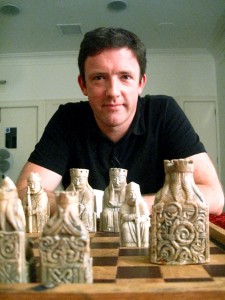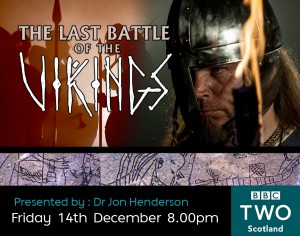
December 14, 2012, by Jon Henderson
The Last Battle of the Vikings
Over the summer I got the chance to work on a BBC documentary looking at the events around the Battle of Largs in 1263. It’s a subject that’s close to my heart as I grew up near Largs and although I was always aware that the battle had taken place there (thanks in no small part to the large plastic Viking that sits outside the Viking Fish and Chip shop), growing up I was never entirely sure why the Vikings had been there and what exactly had been at stake.
The Battle of Largs is one of those great ‘what if’ points in history – the outcome could have threatened the very existence of Scotland. Had the Vikings won its quite possible I would be writing this blog in Norwegian.
In 1263 King Haakon of Norway sailed at the head of a massive armada to teach the fledgling Scottish kingdom a lesson and reassert Viking sovereignty over the Hebrides and the west coast of Scotland. Imagine 120 ships, containing 20,000 men, anchored in the Firth of Clyde, just off the Isle of Arran, waiting to strike – it must have been an awe-inspiring and terrifying site. This was one of the largest invasion forces ever to threaten the British mainland – comparable to the Spanish Armada some 300 years later – and certainly larger than anything the Scots could muster at sea.
Luckily the Scots were led by the wily Alexander III, one of my favourite Scottish kings. He was only 23 years old at the time but was already a shrewd politician and cleverly stalled any actual engagement with the Norse forces, instead sending envoys and playing for time. Based down the coast in Ayr he hoped that the Scottish weather might be able to do what his own forces couldn’t – scatter the armada. Sure enough on the 1st of October the weather broke and the Norse ships were sent into disarray – several longships were driven ashore at Largs. The next morning Haakon managed to get onshore with 1,000 men to salvage the ships and their cargo. That was when the Scots pounced. Haakon’s bodyguard got the king back to the safety of the fleet but on the shore the Norsemen were being beaten. Finally a long ship managed to get ashore to reinforce the beleaguered rearguard and the Norsemen made a stand. The Battle of Largs petered out into a long distance and sporadic shooting match. Neither side had won, it ended in stalemate.
It was the aftermath of the battle that decided things. Given that winter was approaching, the campaigning season was over and King Haakon was forced to disperse his fleet and spend the winter in Orkney. He had every intention of returning the next year but just as the weather had saved the Scots before, fate intervened again. Haakon, an old king by the standards of the day at nearly 60 years old, did not live to see the following spring. He died in Orkney on 16th December 1263. He was the last Norwegian king to mount a military assault on Scotland. Crucially, his son Magnus the Lawmender had no appetite for continuing the fight and just three years later in 1266 he gave up the Hebrides and the Isle of Man to Scotland, in return for 4,000 marks in silver and an annual payment, under the Treaty of Perth. At the same time the Scots recognised Norwegian rule over Shetland and the Orkney Islands.
Although our remit in the documentary was to describe the Battle of Largs we managed to expand the programme to cover the Norse influence in Scotland more widely, looking at why the Norse came to Scotland in the first place and what their legacy has been. As a result I got to visit some fantastic places.
At Rubh’ an Dunain on the Isle of Skye, archaeologists – Colin and Paula Martin – have recently discovered what appears to have been a Viking raiding base. Colin and Paula think the loch was once used to overwinter and maintain Viking vessels, and possibly they were building ships there as well. Crucially Viking boat timbers dating from the 12th century have been recovered from the loch. A man-made rock-cut canal – representing a massive engineering operation – leads from the sea to the loch which could have been used to float boats in. And there are what seem to be the remains of a stone jetty at the head of the loch which we had a look at underwater, planning it using the same sonar technique I used at Pavlopetri in Greece. So far Rubh’ an Dunain is the only known site of its type in Scotland but undoubtedly there are others out there waiting to be discovered.
We also got to see a fantastic new bit of kit being used to create highly accurate 3D photo-moaiscs of the site. It’s a remote-controlled aerial drone built and flown by Colin’s son, Ed Martin,. The drone is equipped with a digital camera and can manoeuvre high above the ground taking highly detailed images. You can see some of the results of his work here: http://www.youtube.com/watch?v=Uqr8VnPVpjk&feature=relmfu
At Rubh’ an Dunain you get a sense of lost world – one connected by the sea. There are no roads into this stunning site, the nearest is 6km away, and at the time of the Vikings, the harbour would have sat directly abreast an interconnected network of sea routes. These ran the length of western Scotland, connecting coastal communities to a much wider Norse world (whether they liked it or not!). Visiting sites like Rubh’ an Dunain really brings home just how vital boat technology was to the Vikings and their descendants.
We also got a chance to visit the boatbuilding yard at Tonsberg in Norway where experimental archaeologists are building a replica of the famous Oseberg ship. Using only traditional techniques and no modern tools they are rediscovering skills and technology which were once widespread in the Norse world. You can see the launch of the vessel here: http://www.youtube.com/watch?v=0tigGYikk6A&playnext=1&list=PL1621F75D59F94209&feature=results_main
At Tonsberg they’re rediscovering skills and technology which were once widespread in Norse Scotland. In Orkney I got the chance to sail on a clinker-built boat that is a living example of this tradition – the Orkney Yole. Until the mid-1960s the Yole was the islander’s motor car and pick –up truck, transporting coal, peats, animals and, of course, passengers. They might have been overtaken by other forms of transport but today the Yoles are still going strong thanks to enthusiasts like Maurice Davidson and the Orkney Yole Association.
You get a further indication of the importance of the maritime dimension when you consider that Bergen, Norway’s second city, is actually closer to Scotland than Oslo the capital of Norway. It was from these Atlantic fjords that vikings not only raided the Scottish and Irish coasts but also eventually colonised the Faroes, Iceland, Greenland – they even gained a temporary foothold in North America.
As well as saying something about maritime connections and the importance of the Viking longship we also wanted to say something about the exquisite Viking art of the time. Norse culture in Scotland was wealthy and sophisticated, it was well connected. To demonstrate this I got up close and personal with one of the most famous treasures of medieval Europe – the Lewis Chessmen.
The Battle of Largs in 1263 marked the beginning of the end for Norse influence in Scotland. The descendants of the Vikings in the Hebrides now looked to Scotland for royal protection not Norway. But the Viking influence remains in boat building traditions, place-names and in our blood. I’ve always found it amusing that at the Battle of Largs festivals people always seem to want to be Vikings rather than Scots. There is still something romantic about them. Of course there was enormous brutality and destruction – you can’t just wish it away – but at places like Rubh’ an Dunain you can begin to see the other side. An inquisitive and questing people from a time when Scotland was at the centre of a network of contacts that was beginning to criss-cross the globe. Perhaps we can trace something of the curious, inventive and restless nature of the Scots and their impact on the wider world to these Viking traits. Next year the annual Viking Festival celebrates the 750th anniversary of the Battle of Largs and I for one intend to be there.
BBC Programme Page http://www.bbc.co.uk/programmes/b01p9fwg
Orkney Yole Association http://www.orkneycommunities.co.uk/yoleassociation/
Oseberg Viking Ship Project http://www.osebergvikingskip.no/eng/
The Vikingar! Viking Experience in Largs http://www.largsonline.co.uk/vikingar.html Viking Experience
Annual Largs Viking Festival website http://www.largsvikingfestival.com/






I am looking forward to the programme about the Battle of Largs, and your clearly very interesting professional perspective ( timbers etc) but I am apprehensive regarding the idea that Scotland was as a result, moved towards some new national sense of its identity. Scotland as you know had been happily a nation for a few hundred years by then. In particular , with the move of David from Dunfermline to Edinburgh over 150 years before, thus securing Bernicia – Lothian as part of the ‘Scottish project’ – my parenthesis.
Scotland had a pretty good 12th Century, and until Edward ist of England came along, a prett4y decent 13th Century.
Regards
Ian Dick